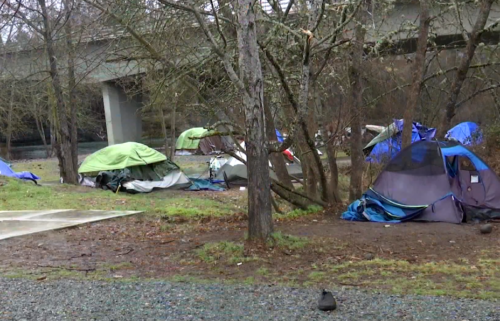What we know about the grand jury decision to not charge officers in police shooting of Jayland Walker

A special grand jury has been tasked with deciding if any of the eight police officers directly involved in the fatal shooting of Jayland Walker last summer will face criminal charges.
By Dakin Andone, Polo Sandoval, Christal Hayes and Celina Tebor, CNN
The eight police officers who shot and killed Jayland Walker, a Black man in Akron, Ohio, will not face state criminal charges after a special grand jury came to its long-awaited decision Monday.
The city has been bracing for a decision following Walker’s death last summer, when officials say the 25-year-old fled an attempted traffic stop early one morning in June and was shot dead. An autopsy revealed he suffered 46 gunshot wounds or graze injuries in under 7 seconds, according to Dr. Lisa Kohler, the county medical examiner.
Walker’s death prompted an investigation by the Ohio Bureau of Criminal Investigation, along with protests over racial injustice and police use of force — a few of which erupted into violence, resulting in damage to local businesses, Akron police said at the time.
Walker was unarmed at the time he was killed, according to police, though officers said Walker fired a gun from his vehicle during the car chase and a gun was found in his vehicle after the shooting — a detail Ohio Attorney General Dave Yost said was “critical to remember” when examining the grand jury’s decision.
Yost also highlighted a movement he said Walker made after he left the vehicle and led officers on a foot chase.
“He reached for his waistband in what several officers described as a cross-draw motion, planted his foot and turned toward the officers while raising his hand,” Yost said, announcing the decision Monday. “Only then did the officers fire, believing Mr. Walker was firing again at them.”
“The law allows officers to use deadly force to defend themselves or others against a deadly threat,” he added.
Since the grand jury proceedings began, city officials hosted public meetings to address concerns about the proceedings and how any decision might impact the community. At one, Police Chief Stephen Mylett said he was “anticipating that there is going to be a response from Akron and beyond.”
The city has established a demonstration zone downtown, along with temporary barriers and fencing around court and municipal buildings — moves a city spokesperson described as purely precautionary. All Akron Public Schools will be closed Tuesday due to the announcement, according to spokesperson Mark Williamson.
Here’s what we know about the shooting of Jayland Walker and the grand jury’s decision:
What the grand jury decided
Yost said the grand jury took more than a week to make its decision due to the large amount of evidence presented.
Ultimately, the panel found “the officers were legally justified in their use of force,” Yost said Monday.
Although there will be no state criminal charges for any of the police officers involved in Walker’s death, civil action can still be brought against them, Yost said.
Of Walker, Yost said: “I grieve the loss of this promising young life.”
A grand jury is an inherently secretive process.
The jury panel, which in Walker’s case was composed of three men and six women, are the only ones allowed in the room, along with prosecutors, witnesses and a court reporter.
The panel’s job is only deciding whether there is probable cause to indict — unlike a trial jury where there needs to be proof beyond a reasonable doubt. A grand jury also only needs a majority of members to indict, while a trial jury must be unanimous.
In Ohio, at least seven of the nine jurors must vote in favor of charges in order for an indictment to come down, but Yost said they were precluded by law from discussing the final vote.
The process is also almost entirely one-sided: There is no cross-examination by the defense, nor any evidence presented from the other side.
Of the nine people on the grand jury in Walker’s case, two were Black, according to Ohio Assistant Attorney General Anthony Pierson.
“My office’s work and the decision of the grand jury is driven by the law as it is, not as it might be,” Yost said. He said his office could not say whether any of the eight Akron police officers involved in Walker’s death testified before the grand jury.
What police say happened
Walker was killed in a burst of gunfire early June 27, 2022, following a vehicle pursuit and foot chase that started when officers tried to stop him for traffic and equipment violations.
Walker fled the stop and officers gave chase, according to a narrated video timeline police played at a news conference July 3, when police released parts of body camera videos from 13 officers at the scene.
About 40 seconds after the start of the pursuit, the narrated video said, “a sound consistent with a gunshot can be heard” in body camera footage, and the officers told dispatch a gunshot had been fired from Walker’s vehicle. Police also showed still images taken from traffic cameras that showed “a flash of light” — purportedly a muzzle flash — along the driver’s side of the car.
“That changes the whole nature” of the incident, Mylett said at the time, turning a “routine traffic stop” into a “public safety issue.”
After several minutes, Walker’s vehicle slowed and he exited and ran, police said. Several police officers got out of their patrol cars and chased him, and officers deployed Tasers in an effort to stop him, police said, but were unsuccessful.
Moments later, police said, Walker “stopped and quickly turned towards the pursuing officers.” Mylett told reporters officers believed Walker was reaching towards his waist and they “felt that Mr. Walker had turned and was motioning and moving into a firing position,” Mylett said, and officers opened fire, killing him.
Walker was handcuffed behind his back after the shooting — a move Mylett said was in accordance with department policy. Mylett indicated at a community event in late March that adjustments would be made to the policy.
Walker had 46 wounds, medical examiner found
Walker suffered 46 gunshot entrance or graze wounds, according to an autopsy by Summit County Medical Examiner Dr. Lisa Kohler, who found the cause of death was multiple gunshot wounds.
Per Kohler, the wounds included:
• 15 on Walker’s torso, where he had internal injuries to his heart, lungs, liver, spleen, left kidney, intestines and multiple ribs.
• 17 on his pelvis and upper legs, where the right major artery going to the leg and the bladder were injured and the pelvis and both femurs were broken.
• One on his face, where the jaw broke.
• Eight on his arms and right hand.
• Five on his knees, right lower leg and right foot.
Though police accused Walker of firing a gunshot out his vehicle’s window, a gunshot residue test was not performed as part of the autopsy, Kohler said, explaining gunshot residue testing can detect specific particles related to the discharge of a firearm “but the results of that testing is not conclusive as to whether the person did or did not fire a weapon.”
The FBI discontinued this testing in 2006, and Kohler said her office discontinued the collection of that sampling a decade later and no longer purchases collection kits.
8 officers placed on leave, then reinstated
The eight police officers “directly involved” in the shooting were initially placed on paid administrative leave pending the investigation, according to department protocol, Mylett said.
They were reinstated by October 10, a decision Mylett attributed to “staffing issues” in comments to CNN affiliate WEWS, acknowledging “there may be some community concern.”
While back at work, the officers were not in uniform or responding to service calls, the Akron Police Department said.
According to information released by the city, seven of the eight officers are White and one is Black.
“The decision to deploy lethal force as well as the number of shots fired is consistent with use of force protocols and officers’ training,” the Fraternal Order of Police Akron Lodge 7 said in a statement last year.
What videos show
The week following the shooting, police released 13 videos from officers’ body cameras — eight from the officers directly involved in the shooting and five others from others who were at the scene.
The videos were released according to a city ordinance requiring video footage documenting an active police officer’s use of force to be released within seven days of the incident.
Toward the end of the pursuit, some of the footage shows the silver car Walker was driving stopping before he begins to exit the driver’s side.
At least one officer shouts, “Let me see your hands,” and tells him not to move. The video shows Walker getting back into the car, which slowly moves forward. He is then seen getting out of the passenger side door and running from officers.
At least one officer again yells for Walker to show his hands, one video shows. The foot chase continued for several seconds, before a series of gunshots ring out over seven seconds.
The videos end right after the gunshots were fired and do not depict police officers’ efforts to provide medical care, though police say they attempted first aid after the shooting.
Walker was declared dead at the scene.
Through a Freedom of Information Act request, CNN obtained in early September 24 more heavily redacted video clips showing more than four hours of the shooting and its immediate aftermath.
Each video contains several sections where the footage is blurred or blacked out, or where audio is muted. The city told CNN at the time this was done to redact officers’ identifying information.
In several videos, gunfire is heard for seven to eight seconds, followed by officers’ attempts to determine whether Walker is armed while he lies face-up and non-responsive on the ground.
“Can anyone see the gun?” one officer is heard repeatedly asking, as a group of officers stand with guns still aimed at Walker. “Where is the weapon at?” one is heard asking in several videos.
Several officers are heard rendering first aid, shouting for light and asking for tourniquets and packing gauze.
None of the videos showed the inside of Walker’s car, though some show officers approaching the vehicle after the shooting. “It’s got a firearm in it,” one officer is heard saying.
Police are seen in other footage trying to sequester police who fired at Walker while discussing collecting their body-worn cameras.
The-CNN-Wire
™ & © 2023 Cable News Network, Inc., a Warner Bros. Discovery Company. All rights reserved.
CNN’s Zachary B. Wolf contributed to this report.



